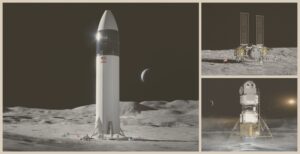As the final step in landing astronauts on the moon, the Human Landing System (HLS) will play a significant role in the success of the Artemis program. However, the path forward is as precarious as it is aggressive, and NASA’s decision to rely on a sole company (SpaceX) to land our astronauts on the surface of the moon has made a challenging operation even riskier. Perhaps more importantly, funding a single HLS provider deprives NASA of the benefits of competition among contractors.
NASA’s decision to award nearly $3 billion to SpaceX in April to produce the HLS has resulted in a rising tide of political and expert opinion calling for NASA to issue a second contract. Not only have both overlooked parties – Dynetics and the National Team led by Blue Origin – protested the award, but the Senate has voted to require that NASA issue a second award in order to restore competition and reduce program risks. A House appropriations subcommittee has also advanced a bill that increased funding for the HLS program, but was silent as to any requirements in regards to spending.
Competition is the engine of entrepreneurialism. Without it, SpaceX and other companies will lack the impetus to produce a superior product at the best price. In mature industries, a competitive marketplace is maintained through the enforcement of antitrust laws. However, when NASA creates an industry from whole cloth, it is the responsibility of NASA to also create the conditions of a competitive marketplace: by awarding multiple contracts for the product and service. Our capitalist system, defined by healthy competition, is the greatest advantage that the United States has as other countries, including China and Russia, jostle in space for geopolitical supremacy. In a mission as complicated as returning to the moon, the United States needs the most innovative technologies that only a competitive market can produce.
Kathy Lueders said it best on her first day as the head of NASA’s Human Exploration and Operations Mission Directorate, when she christened her era of leadership with the motto “exploration is a team sport.” NASA’s vision, as she went on to explain in her inaugural statement, is for NASA to create a competitive marketplace where NASA will simply be another customer, shopping for the best deal to put their payload in orbit or on the moon:
We took a risk with industry by encouraging commercial innovation in a new market with the end goal of government becoming a customer of low-Earth orbit services, hopefully one of many.
Her comments show obvious pride (and rightly so) in NASA’s innovative procurement programs in recent years. NASA played a groundbreaking role in funding the development of new reusable rocket technology which transformed the U.S. launch service industry. Programs calling for Commercial Crew Development, Commercial Resupply Services, and Commercial Orbital Transportation Services spawned a legion of launch service providers that operate (or plan to operate) in low Earth orbit, with the most notable being SpaceX, Boeing, and Northrop Grumman.
How did NASA accomplish this? By awarding multiple contracts after competitive bidding. The bidding process ensures healthy competition during the contest for a contract – but the awarding of multiple contracts ensures that the competition will continue post-award because there will be a multiplayer industry where companies will continue to compete for contracts (whether with NASA or with other customers).
NASA understands the benefits of competition and has largely moved to the model of awarding contracts to multiple companies. In the call for bids for the HLS project, NASA foreshadowed their intent to give multiple awards; but then, clearly under financial pressure after Congress allocated only 25% of the requested funding for the HLS program, NASA issued a single award to SpaceX. By doing this, NASA eliminated all competition and with it all of the benefits of the marketplace.
Along with eliminating competition, the decision to issue a single award jeopardizes reliability. Lueders said as much in her inaugural statement: “We took a risk with industry . . .” The risk is that, despite NASA’s funding, the selected companies could fail to reliably deliver the needed products/services at a reasonable price. As Scott Pace, formerly executive secretary of the National Space Council, recently pointed out: “It is very dangerous to go to just one [contractor].” The risks of working with a single contractor are nothing new. In the days of the Apollo program, NASA ensured the reliability of a contractor’s work by being far more “hands on” in how they monitored it. Today’s procurement model mitigates reliability risk in a different way: by issuing multiple awards, and thereby maintaining redundant providers of the product/service.
It is not too late to correct course. Both unsuccessful bidders still have viable bids. Even smaller split awards would maintain the competition model. If the reduced size of the awards slows the timeline, then Congress will simply have to increase funding. At the moment, it appears that Congress may intervene and force NASA’s hand (if the House follows the lead of the Senate). But it would be far better if NASA took the opportunity of its own accord, after considering the actions of the Senate and expert opinion, to issue a second (or even a third) award in order to maintain a competitive field in the industry and enhance overall reliability of our human landing systems. By taking action, NASA would be sending a clear message that it is dedicated to creating a vibrant competitive industry of lunar landing technology that will help ensure that the U.S. maintains its position of leadership in space.
Prof. Mark J. Sundahl is a professor of law and the director of the Global Space Law Center at Cleveland State University. He currently serves on NASA’s Regulatory and Policy Committee and is the principal of Astralex LLC which provides consulting services to a range of industry clients, including a company involved in the HLS bidding process. All opinions are those of the author alone.



